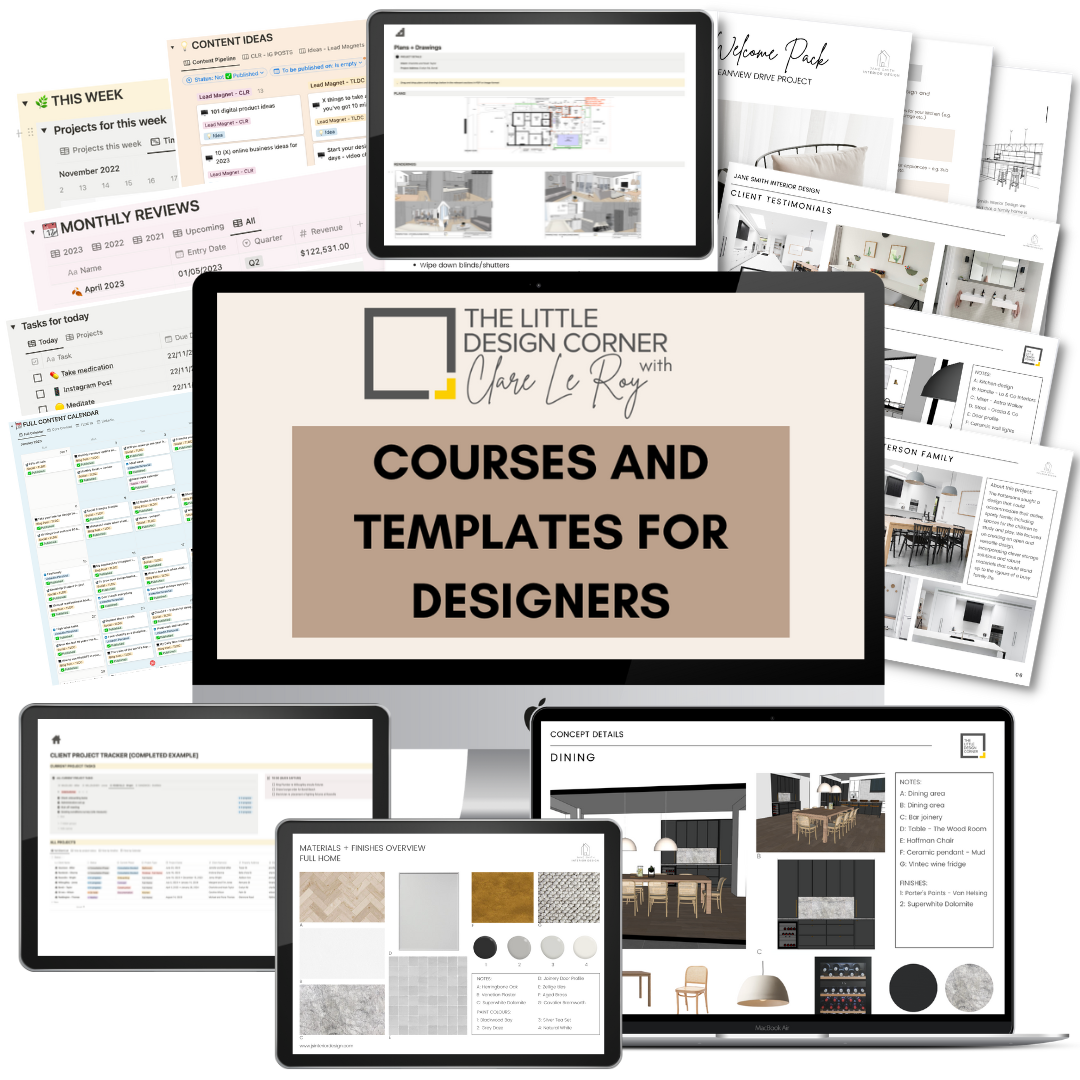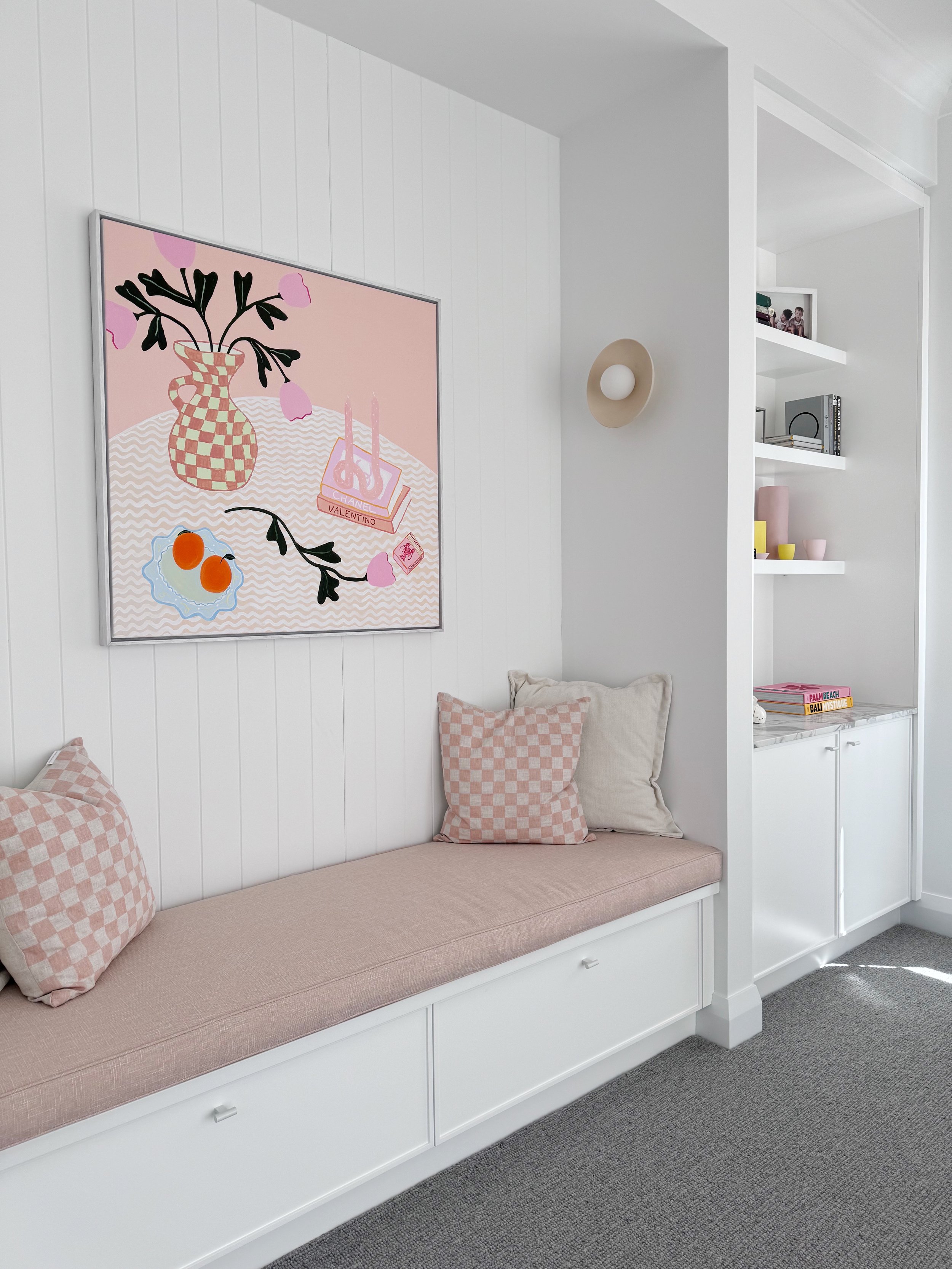Business models to avoid as a designer (and what to do instead)
I’m a massive supporter of trying to diversify your design business with multiple streams of revenue. But not all business models are suitable for our industry.
So in this post I want to share some business models that many interior designers are tempted to pursue (thinking it will help them scale) but normally end up being hard to run, risky and not particularly profitable.
After that I’ll share some better business models that I think can transform your business and help you grow and scale.
Real Estate Styling
Real estate styling is how I first got started, and frankly, I hated every second of it!!
Here’s why:
Real estate styling is more of a logistics operation than a design venture.
The need to move, store and maintain a large inventory of furniture and accessories is expensive (and basically like moving house every day as your career!).
Keeping this inventory in line with current trends requires constant investment.
The nature of real estate staging often requires quick turnarounds and high operational efficiency, which can be stressful.
Also, revenue is tied to the ups and downs of the real estate market.
Real estate styling is a skill set that differs significantly from those required in traditional interior design. Unless you love moving house every day of your life - it’s probably not the business model for you! It certainly wasn’t for me :)
Opening an Online Furniture or Accessories Store
Although launching an online store can seem like a good way to generate additional income, it comes with its own set of challenges.
These include;
the need for capital
inventory management
logistics
customer service
the need for a separate marketing strategy (e.g. often not easy to combine your design services and shop into one Instagram page or website).
Having an online store is essentially a second business and not one that’s easy to run ‘on the side’. Unfortunately, many furniture and accessories stores are going into liquidation, indicating how hard this business model can be.
Offering E-Design Services
Many designers think e-design will be a way to make more money and do less work. But you need a lot of clients to make money from e-design.
Generally, making each design still takes almost the same amount of time as traditional interior design work but you normally get paid less (as it’s not a service that is as valued by clients as traditional 1:1 design services). In addition to this there's a large amount of competition, including people who are willing to do it for much less money than you.
For these reasons, e-design is a really hard way to scale a design business unless you’ve got a large online audience and/or staff to help you fulfil orders.
Creating an App
Developing a mobile app is not only costly but also requires a deep understanding of tech, something that most interior designers are not proficient in.
If you can’t brief an engineer properly, you’ll be throwing money down the drain. The app then requires constant updates, bug fixes and customer service which is expensive to maintain.
In addition, to make money from an app, you need hundreds of thousands of downloads, which means you need a huge community for this to be a viable business model.
Subscription Services
A monthly or yearly subscription or membership model is another option lots of designers consider to scale their business. This can seem attractive for recurring revenue, but the demand for consistent interior design services on a subscription basis is typically low.
What are clients going to pay you for month after month?
What value are you providing them that will keep them in your membership?
Unless there's a unique selling proposition that makes a subscription compelling, this will likely be a waste of resources and you’ll see constant churn with your members.
Drop Shipping Furniture or Decor
The idea of not having to handle inventory might seem appealing, but drop shipping normally comes with slim margins, quality control issues and customer service headaches.
When you are onselling a product created by another company, without any quality control or handling yourself, you are putting your reputation on the line. If a customer is unhappy, it will be a reflection on you, not on the maker of the item they have purchased.
If you value your brand, this is also not a good business model!
So although diversification is key to business growth, not all opportunities are what they seem.
Instead here are a few business models that I think are worth exploring (beyond obviously 1:1 client services that you are likely already doing)…
Online Courses or Workshops
Scaling your business online is my favourite business model and is how I’ve grown my own design business to multi 7-figures a year in revenue.
Here’s why I love it:
Passive income: Once a course or workshop is created and set up, it can be sold to an unlimited number of people with minimal ongoing effort (beyond some student support). This provides a steady stream of passive income (even while you sleep!)
Scalability: You're not trading time for money in the same way you do with 1:1 client work.
Low overheads: The cost of distributing your course to each additional customer is minimal. Adding additional students to your course or workshop doesn’t mean more work for you.
Lifestyle freedom and flexibility: Selling online courses allows you to work on a flexible schedule, freeing up time to focus on other aspects of your business or being able to spend time doing whatever you want :)
Collaborations with Volume Builders or Developers
These can be highly lucrative partnerships for several reasons:
Consistent work and revenue stream: Volume builders typically work on multiple projects simultaneously, providing a consistent stream of work if you’re their exclusive designer.
Bigger projects: Volume builders normally build full home projects (or even multi-resi projects), this means higher quality, more interesting work for you (and more revenue as well!)
Brand exposure: Partnering with established builders will build your brand recognition - your design work will be shared to their audience = new leads without extra work.
Streamlined processes: Working consistently with the same partner allows for more streamlined communication and procedures. This can make your work more efficient and reduce time and costs in the long run.
Support Services to Other Designers
Offering support services to other designers can be a mutually beneficial strategy that allows for business growth and industry networking.
Here are some reasons why this business model works so well:
Revenue diversification and stability: By offering support services to other designers you will build an additional revenue stream. This can cushion your business against market ups and downs and make you less reliant on always needing to your own new clients.
Resource Sharing: Collaboration with other designers allows for the pooling of resources - e.g. staff, technology, samples for projects etc. This can result in cost savings and increased efficiency for all parties.
Networking: Providing services to peers in the industry allows you to create valuable relationships that can lead to more opportunities down the track - e.g. referrals.
Here’s some examples of services you could offer:
Drafting
technical drawing
3D modelling
rendering
material sourcing
marketing
social media support
admin support
Create VIP Design Experiences
Think about how you can differentiate what you do in the market and create VIP experiences that you don’t see anyone else doing. Sell these as your point of difference.
For example, you could offer high-end clients an exclusive, all-in-one package that includes not just interior design, but also a range of other services like personal shopping, fine art curation, pantry organisation, a housewarming event after the project completion - there would be so many ideas so think outside the box and turn it into something that high-end clients would have FOMO about missing out on.
Narrow Niching Opportunities
Think about what affluent clients spend their money on and narrowly niche your services to create a point of difference in the market. Some examples of this could include children’s interior design, pet interior design, high-end relocation, house finding + furnishing, biophilic design, boats/yacht design or parents helping their teens design their college/university dorm rooms.
To do this you would focus all your content creation on social media that is targeted specifically towards the niche you’ve chosen. Don’t deviate - become THE expert in your niche.
Create a business that stands out in the sea of hundreds of thousands of designers by thinking differently to them. Don’t just do what you see everyone else doing or think that you have to run your business the way “things have always been done” - think about how you can do something that brings value to the market and provides a point of difference.
Stop doing the same boring stuff that’s already been done.
How can you stand out?
Thanks for reading and catch you in my next post :)
Clare x
Dr Clare Le Roy
Courses and Templates for Designers and Architects
DO YOU WANT TO….
Improve your professionalism?
Find more clients?
Bring in more revenue?
Create better systems and processes?
Then check out my business courses and templates for designers and architects.
These courses and templates leave you with work done - not just a long list of things you need to do next. We have a really strong focus on taking action and getting things created that improve your business.








